GRAPE VARIETIES
AND THEIR WINES
The Alpine arc is considered to be a cradle for grapevine diversity: DNA studies have shown that the French Alps wine regions are home to some of the ancestors of internationally famous grape varieties. In the past two decades, researchers, vignerons and wine enthusiasts around the world have realized the need to conserve this grapevine diversity. In the French Alps, the CAAPG continues to ‘rescue’ almost extinct grape varieties.
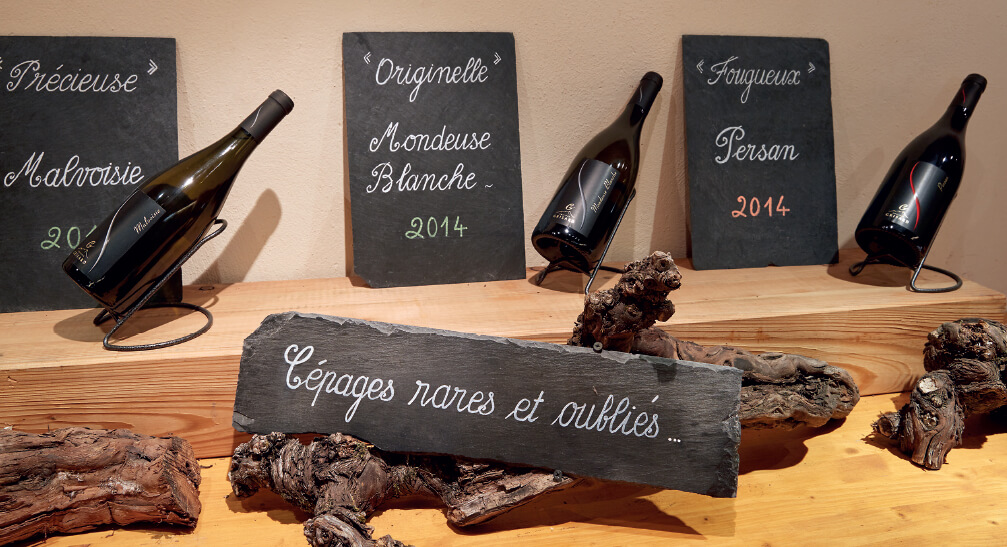
Philippe Grisard’s tasting room highlights the wines he makes from rare Savoie grapes.
Ampelography, the study of grape varieties, does not only use DNA testing and traditional grapevine identification techniques, it also uses historical research to help determine where a grape variety originated. In 1803, which fell in the period when Savoie was first annexed by France, Napoleon I required all the regional officials to list their grape varieties, with their synonyms, in order to create a national grape inventory. No easy task. The document drawn up in Savoie lists about 30 white and 30 red grape varieties and serves as a useful resource for confirming technical studies and for understanding the confusing synonyms once used in each locality. A further inventory was written in 1887 as a monograph by Pierre Tochon, Savoie’s regional agricultural director.
The DNA identification in 1998 of the parents of the Rhône Valley’s Syrah variety as Dureza (from the Ardèche department) and Mondeuse Blanche, believed to be a Savoie grape variety, was a breakthrough to understanding other local varieties. Further testing has shown that many grapes grown in Savoie, Ain and Isère have a close relationship with varieties from the Rhône Valley.
Many other French Alpine varieties are descendants of the almost extinct Gouais Blanc variety, which is a parent of – among numerous other offspring – Gamay and Chardonnay (in these cases the other parent was Pinot). There are also family connections to indigenous Jura grape varieties, most notably Savagnin.
In France today no one may grow a grape variety to make wine for commercial use, even under the Vin de France label, unless that grape is listed on an official government register of grape varieties – many historic varieties are not (or were not until recently) listed. In order to rehabilitate Alpine grape varieties, the CAAPG works with French official bodies such as INRA (the National Research Institute for Agronomy), which looks after the world’s largest vine conservatory at Domaine de Vassal in Montpellier, and the IFV (the French Vine and Wine Institute), which manages the conservatory of registered varieties and approved clones. The many organizations involved in this work and in the work of developing suitable clones are described on the home page of the Plant Grape website, which catalogues all varieties on the official French register. I am indebted to this website, which is available in the English language at http://plantgrape.plantnet-project.org/en/, as well as to Dr José Vouillamoz, grape geneticist and co-author of the book Wine Grapes.
Savoie
By the time that Savoie aspired to become an Appellation Contrôlée wine region, it had already shunned many traditional varieties that were known to give poor yields or that failed to ripen regularly due to diseases. Some of these were left out of the list of authorized varieties. Nevertheless, the approved white varieties Jacquère, Altesse, Gringet and Molette along with the red Mondeuse and Persan bear testimony to the diversity of unusual grapes here – except anecdotally, these remain grapes that grow only in the French Alps. Between them these unusual varieties represent two-thirds of Savoie’s plantings.
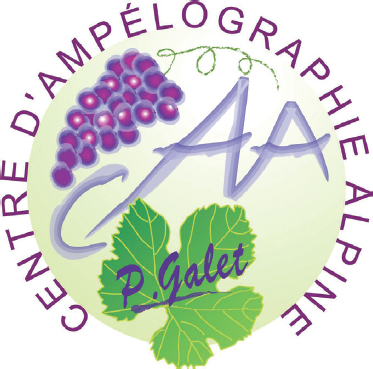
It is thanks to the Centre d’Ampélographie Alpine that many grape varieties are being saved from extinction.
Bugey and beyond
When the Bugey region became VDQS in 1958, it had so few plantings of Vitis vinifera, having planted mainly hybrid varieties after phylloxera, it was as if the region had a blank slate. There was, however, a history of growing Savoie vinifera varieties including Jacquère, Altesse and Mondeuse. Local agricultural advisors, notably Claude Paul, who helped to pull the wine region into the modern age, believed traditional varieties were too difficult both to grow and to market and recommended Gamay and Chardonnay in particular and also Pinot Noir. Between them, these three varieties represented over 80% of Bugey’s plantings in 2016, meaning only 90ha are planted of all the other varieties between them. In Cerdon, Gamay was adopted as the principal variety, along with a small amount of Jura’s Poulsard, both having been recategorized officially as ‘aromatic varieties’ and thus suitable for making ancestral method wines.
Isère and Hautes-Alpes, struggling to survive at all in these past few decades and enjoying the more flexible IGP regime, pursued mainly international varieties until a few pioneers decided to rescue some traditional varieties. As for the Diois, home to sparkling Clairette de Die, its main grape of Muscat à Petits Grains eclipses the Clairette grape, although there are healthy amounts of the latter.
Obscure grapes
Among wine lovers worldwide, almost exaggerated excitement is accorded to the revival of the more obscure French Alpine varieties. Some, such as Persan and Mondeuse Blanche in Savoie, Verdesse and Etraire de la Dui in Isère and Mollard in Hautes-Alpes, are suddenly considered almost mainstream despite occupying, at the time of writing, tiny areas of less than 20ha each. Others are so obscure that I have yet to taste a wine from them apart from occasionally those made in demi-johns as micro-vinification experiments – see box, here. However, the importance of the revival of these obscure varieties, which often have long growing seasons and relatively low natural sugar levels, becomes increasingly evident with climate change leading to ever-warming summers in the French Alps.
How this chapter works
White grapes are shown first, divided into main white grape varieties, rare local grape varieties and other grape varieties (mainly international). Reds follow with the same breakdown. The heading also names the French Alpine regions where the grape is grown in order of importance.
For the main varieties I give an indication of how wines from these grapes are typically made and taste. For rare varieties, and the less planted international varieties whose characteristics are well known, the wines are described in the relevant producer profiles. The tasting characteristics of the many French Alpine sparkling wines are included in the chapter on sparkling wines.
The vast majority of wines covered in this book are single-varietal wines. Blended wines are described individually within the producer profiles.
MAIN WHITE VARIETIES
Altesse
Savoie, Bugey, Isère
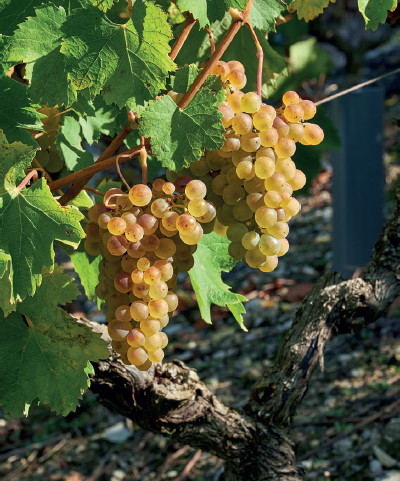
Altesse has historically been known as Roussette, which derives from the French word roux (‘russet’) – these bunches on the Marestel slope in Jongieux are ready to pick.
Altesse is the finest indigenous white grape variety of Savoie. It is the only grape permitted for AOC Roussette de Savoie and it is also the principal variety in Seyssel; it is grown in neighbouring Bugey for AOC Roussette du Bugey. Small areas have been replanted in Isère, where it was also a traditional variety. The history of Altesse is full of fables, but DNA testing has shown that the variety is genetically similar to Chasselas, making it highly likely that it originated somewhere in the area between Lac Léman and the Rhône river. It is believed that in the early 16th century the Duc de Mareste planted Altesse in the vineyards of Château de Lucey, where there is a vineyard slope named Les Altesses, and possibly also at Château de la Mar in nearby Jongieux on the Marestel slope. Seyssel makes an even earlier claim – that it was planted on the hillsides of Corbonod by the Arvières monks from the 12th century.
Today on the increase, Altesse represents about 14% of Savoie’s plantings, with just under 300ha, of which a little more than 50ha are in AOC Seyssel. In Seyssel it is the grape for its main still wine AOC and is the minority part of the sparkling blend with Molette. The largest concentration of Altesse is grown near Jongieux, in particular on the Marestel slope. Marestel is one of four crus for Roussette de Savoie, the others being the small Monthoux area nearby, Frangy to the north in Haute-Savoie and Monterminod, close to Chambéry. Altesse is also planted in the vineyards of Apremont, Abymes and Chignin (these names are not used on the labels: they must state simply Roussette de Savoie) and along the Combe de Savoie valley. There are tiny amounts in Ayze (Domaine Belluard) and Dominique Lucas of Les Vignes de Paradis has planted some in the Lac Léman area.
In Bugey, despite some very good-quality wines, it struggles for recognition, with about 20ha used for Roussette du Bugey and another estimated 10–12ha as part of the blend for Montagnieu and Bugey sparkling wines. There are two Roussette du Bugey crus: the tiny Virieu and further to the west Montagnieu, where most of Bugey’s Altesse is grown. There is also some in Isère and in scattered vineyards in Savoie outside the AOC regime, either for Vin de France or IGP Vin des Allobroges.
The grape variety was for many years referred to as Roussette and it still is in Seyssel and Bugey, although in Seyssel they are no longer allowed to state Roussette de Seyssel on their labels, much to their chagrin – it has to be simply AOC Seyssel. The name Roussette (‘russet’) comes from the fact that the grapes when ripe take on a reddish hue – and earlier in the season, so do the tips of the new shoots. There are three approved clones.
Altesse is a tricky grape to grow, requiring a lot of work in terms of canopy management and it is prone to both mildews, as well as budding early, so it is very susceptible to frost damage. It ripens fairly late and can benefit from warm autumns, giving moderate yields. As harvest approaches there is some risk of grey rot, but – especially in Marestel above the Rhône river – noble rot usually appears and most growers there prefer to pick it when bunches are 10–30% affected.
Tall stories of Altesse
Everyone loves a good ancestry story, then along comes DNA testing and destroys it all. The Savoyard tale, proudly told, is that Altesse was introduced from Cyprus. Most stories relate that it was brought over in the early 1430s by the daughter of the King of Cyprus, Anne of Cyprus, also called Anne de Lusignan, who was to marry Louis of Savoie, later Louis I, Duke of Savoy. Another version states that it came over a century later via Charlotte de Lusignan, who married a later Savoie Louis. Considering the power of the House of Savoy and its inter-relationships with the courts of Europe, these stories appear feasible, and were handed down through the ages as received wisdom. In the late 18th century they appeared in the writings of an important local nobleman, the Marquis Costa de Beauregard, and the story was picked up by Pierre Tochon in his 1887 monograph.
The name Altesse in French means ‘Highness’ and this conferred nobility on the grape. The fact that it was known for centuries to produce very fine wine in the Jongieux area must have helped.
Confusingly, as interest grew in Savoie wines in the 1980s, the ampelographer Pierre Galet, having found no resemblances between Altesse and any other French varieties or those of Cyprus, and having recently visited Hungary, determined that it was the same as the Furmint grape of Tokaj. As well as similarities in the grapes’ conformity, the fact that Tokaji wines were known in royal households lent credence to the Altesse name, he thought.
DNA testing has proved both the Hungarian and Cyprus connections to be tall stories, but they are often repeated in the region. My personal theory is that vines probably were brought from Cyprus as a gift, but I cannot imagine that they thrived in the very different climate of Savoie. They were probably replaced by a local grape, the one we now call Altesse. In 1998 some Altesse cuttings were taken from Savoie to the KEO winery in Cyprus in the belief that this was rehabilitating an ancient Cyprus grape. It is planted on a southeast-facing limestone slope at 700m altitude, but the wine is a rather simple dry white, devoid of much character.
Altesse wines
Altesse gives relatively high potential alcohol levels and crisp acidity, which has long been considered by many vignerons to require balancing with (often excessive) residual sugar. AOC rules have been tightened up to restrict residual sugar to 8g/l for Roussette de Savoie, Seyssel and Roussette du Bugey. Most wines are made in neutral tanks although there are a few excellent top-end Altesse wines made with oak fermentation and ageing. The jury is out about malolactic fermentation: some vignerons encourage it, others don’t.
The best Altesse wines seem dry (even with levels of sugar up to about 6g/l), balanced with real mountain freshness and full-flavoured too. The steep Marestel slope gives especially high sugars – growers often wait for some noble rot to form and this may confer a honeyed character, with stony, yellow fruit flavours and some exotic floral character. Other areas may give vegetal (not always unpleasant), herbal, citrus, pear and/or quince flavours, and from some terroirs, including Montagnieu in Bugey, the stony character can show particularly well. Wines from Altesse are frequently bottled and released much too early; even simple examples take several months to evolve. Nearly all well-made Altesse wines can age for five years easily, and I have tasted top Altesse wines from Domaine Dupasquier and Domaine Prieuré St-Christophe of 20 years and more, which have aged beautifully. Beeswax and truffles are very prevalent notes in older Altesse, and if judicious old oak-ageing is used, it adds another dimension and complexity. Most Altesse wines are supremely food-friendly.
In certain vintages a few vignerons will make excellent late-harvest examples, with slight sweetness offset by fresh acidity. There is no official Vendange Tardive category and they must therefore be labelled Vin de France. Increasingly Altesse is used in sparkling wines, where it can provide finesse and length to a blend, including for Crémant de Savoie where up to 60% is allowed. Some fine 100% Altesse sparkling wines are made, such as in Frangy and Jongieux. In Seyssel sparkling the current limit is 25% but in practice more is used. It is typically part of the Montagnieu Brut blend in Bugey. Outside of the French Alps, a tiny amount is grown in Switzerland.
Bergeron/Roussanne
Savoie, Hautes-Alpes
Many people consider Bergeron, the local synonym for Roussanne, to be the finest white grape grown in Savoie, although it has a rival in Altesse. Savoie has just over 90ha of Roussanne planted in Chignin and the neighbouring vineyards of Francin and Montmélian to make Chignin Bergeron, which must be 100% Roussanne. A few hectares are grown outside the Chignin Bergeron delimited zone in Savoie – the wines are not entitled to AOC, so are IGP Vin des Allobroges. I know of no plantings in Isère, but it certainly was grown in the past, usually under the synonym of Fromenteau. There is a little grown in Hautes-Alpes.
Roussanne’s origins are in the Rhône Valley and DNA testing suggests it is either an offspring or a parent of Marsanne. It is not known for certain when it first arrived in the Savoie vineyards or when it was given the name of Bergeron, the synonym Barbin or the more poetic name Prince de Chignin. French texts disagree as to whether it could have been present in the 11th century, when white wines of Chignin were first mentioned, or whether it was a more recent arrival in the 18th or 19th century. By the end of the latter it was highly prized, but then almost disappeared after phylloxera, with very little being replanted – in 1957 less than 2ha was grown. The revival came slowly from the 1970s, with vignerons André Quenard, Jacky Quenard (see Philippe Viallet) and René Girard-Madoux (father of Yves) being among those championing the grape.
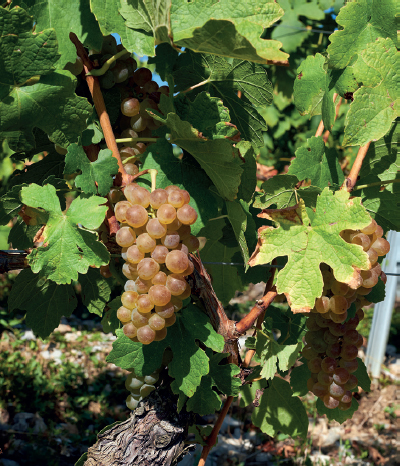
Roussanne is known locally as Bergeron and has its own AOC designation, Chignin Bergeron. The wines are some of the most prized in Savoie.
In the Chignin appellation, the steepest, south-facing rocky limestone slopes are reserved for Bergeron plantings and here it thrives, although in warm vintages it can suffer from heat stress and/or gain too much sugar too fast. In the days when reliable high production was desired, it would not have fitted the bill because it produces modest yields and is prone to oidium and to botrytis bunch rot (bad or, sometimes, noble).
The Bergeron synonym is considered useful to differentiate Roussanne from Roussette. It probably got its name from a delicious late-ripening variety of apricot, also from the Rhône region, but grown in Savoie too. No surprise that apricot aromas are prevalent in many Bergeron wines.
Bergeron wines
When farmed correctly, especially with warm and sunny early autumns, Bergeron produces very ripe, golden grapes, sometimes with a certain amount of noble rot. Chaptalization is rarely required and the great attraction of Savoie Roussanne is that there is usually more natural acidity than when it is grown in the Rhône Valley. This acidity offsets the sometimes blowsy, exotic fruit flavours of a ripe year. A decade or two ago, in the days of higher yields and poor farming, there was a trend for sweeter Bergerons and when malolactic fermentation was used as well, the wines could be very flabby. Today, there are more dry Bergerons, although the ripe flavours and alcohol levels of 13% or more may give an impression of residual sugar.
Fine Bergeron has a pale gold colour, with notes of apricot or even more exotic, sometimes dried, fruits along with flowers such as acacia or jasmine, particularly attractive if honeyed from a touch of botrytis. On the palate the best achieve a balance of richness, weight and acidity, along with flavours similar to the nose. These are wines that ought to be able to age for five years and more. For vignerons in Chignin, Bergeron is their pièce de resistance and several produce two, three or more cuvées, with some using oak fermentation and ageing, providing great depth of spice and complexity. There are some very classy examples.
Chardonnay
All regions
Chardonnay was not traditionally grown in Savoie or in Bugey prior to phylloxera. Today, however, it is by far the most important white variety in Bugey, used for still and sparkling wines, with about 160ha, about one-third of the planted area there. It is the only permitted variety for white Bugey Manicle and it is on this classic clay-limestone rocky terroir that it currently gives its finest expression; it also has potential on other steep, stony slopes such as at Mataret, where Thierry Tissot has vineyards, or above Culoz, on the foothills of the Grand Colombier.
In Savoie Chardonnay has had an up-and-down existence since the 1960s. The presence of the vine nurseries in the Combe de Savoie meant that there was a ready supply of Chardonnay vines, and there was added incentive from 1973 when the AOC authorized Chardonnay as part of white blends with Jacquère for Apremont and other crus. It was even allowed up to 50% with Altesse for the Roussette de Savoie appellation (although this was not for crus, such as Frangy or Marestel, and is no longer allowed). The rules changed in 1998, and it has since declined. The one tiny enclave where it really can shine is at Brison St-Innocent, above the Lac du Bourget. Today it represents about 4% or 80ha of plantings and is rarely replanted, though that may change if Crémant de Savoie is successful. Some growers already use it in the blend, in which up to 40% is allowed.
Chardonnay is grown in Isère by some producers; there is some grown in the AOC Châtillon-en-Diois, where Jaillance makes decent examples; and there are also plantings in the Hautes-Alpes vineyards.
Chardonnay wines
Bugey’s best Chardonnays, such as Manicle, are worth seeking out, with characteristic crisp acidity and minerality showing a fine marriage with the terroir. In Savoie, Chardonnay is rarely valued in the same way or even planted on the best sites. The few good still wines show a hint of Alpine freshness, but they are usually a triumph of winemaking over terroir.
Chasselas
Savoie, Coteaux de l’Ain
It should be no surprise that Chasselas, the quintessential Swiss grape, is grown in Haute-Savoie, in the AOC Savoie vineyards on the southern slopes above Lac Léman, east of Geneva. It was cited in the 1803 grape inventory and there would once have been many more plantings, but today it covers less than 100ha. Its strongholds are in Crépy, Ripaille, Marin and Marignan and there are a few other scattered AOC and IGP areas. A little is grown in the IGP Coteaux de l’Ain Pays de Gex, just across the border from Geneva.
Despite Chasselas being once ubiquitous in France (mainly as an eating grape) and having the same name as a village in Burgundy’s Mâconnais, historical research along with DNA analysis leads current thinking to confirm its origins as somewhere near Lac Léman, either from Switzerland or across the border in Haute-Savoie. The Swiss Valais synonym Fendant is occasionally seen in historical texts on Savoie. Another synonym is Bon Blanc (‘good white’), used in Seyssel, where this variety is said to have been widely grown pre-phylloxera.
Chasselas can be an erratic producer, prone to very high yields if conditions and training allow, but also subject to coulure and millerandage, which will reduce yields naturally. The breezes off Lac Léman help keep away frosts in most years, but oidium can be another problem. It ripens relatively early and growers often fear storms and pick before complete ripeness; Dominique Lucas of Les Vignes de Paradis believes it can be left much longer on the vine and extends his Chasselas harvest by several weeks, if not months.
Chasselas wines
It is all too rare to find a Chasselas wine here that reaches the quality of those from the finest vineyard sites on the other side of Lac Léman in Switzerland’s Vaud canton. The vineyards are not nearly as steep on the French side and the soils more fertile and less rocky.
Chasselas can rarely achieve even 11.5–12% naturally and the vast majority (Lucas is the big exception) are chaptalized to this level. It is often incorrectly described as being naturally high in acidity, but on both sides of the border its problem has been high yields and lack of ripeness. Malolactic fermentation as a means to soften it, common in Switzerland, is also done by some producers in Haute-Savoie. In Crépy there was a tradition for perlant or spritzig whites – the Mercier family having coined the rather amusing term crépytant. The bubbles of retained carbon dioxide can balance the acidity and help mitigate the combination of rather bland flavours and little weight.
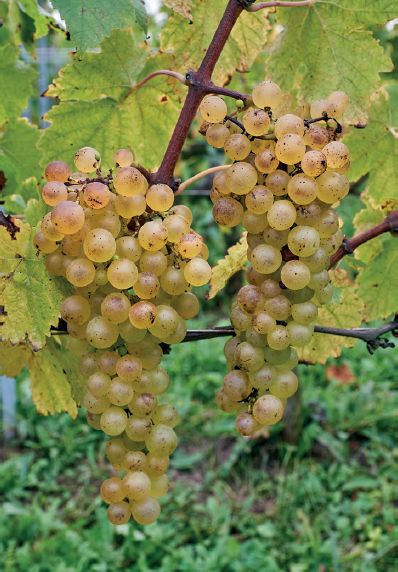
The berries on Chasselas bunches can take on a yellow colour if left hanging late, as practised by organic producers such as Château La Tour de Marignan.
A good Savoie Chasselas can be delightful, with notes of hawthorn and fruit salad on the nose; dry, light, fresh and slightly citrussy or appley on the palate, but these examples are all too hard to find. The wines that offer more character have received better attention both in the vineyard and the cellar and prove it is possible for fine Chasselas to be made – I hope there are more in the future.
Clairette
Diois, Hautes-Alpes
An old grape variety, Clairette is likely to have originated in southern France and has existed in the Diois for many years. It is not really known which came first, the name of the grape or the wine Clairette de Die: it derives from the word clair, the French for ‘pale’, and this could have described the grape berry colour or the wine. It is a rustic variety, best grown on stony, calcareous soils, and is fairly disease resistant. It ripens considerably later than Muscat.
Today there are 250–300ha of Clairette in the Clairette de Die AOC zone, some of which is used for the dry sparkling version of Clairette de Die, which must be 100% Clairette, and for Crémant de Die (minimum 55% Clairette). Up to 25% is allowed in Clairette de Die Méthode Ancestrale, the majority of the blend being Muscat à Petits Grains – it is useful to add acidity to the blend in warm years. The Clairette de Die wines are described more fully in the chapter on sparkling wines.
A tiny amount of dry, citrussy still wine is made under the Coteaux de Die AOC and there is a little grown for still and sparkling wines in Hautes-Alpes.
Gringet
Savoie
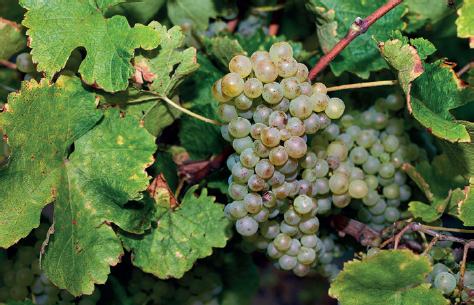
The rare Gringet variety is grown only in the villages around Ayze, where Domaine Belluard is the most famous vigneron.
Grown only in the Ayze vineyards of Haute-Savoie, Gringet has been at risk of extinction for decades, if not centuries, and today there are only around 20ha left. It grows in some of the highest altitude Savoie vineyards on the south-facing slopes above the classic Alpine valley of the Arve river, about halfway between Geneva and the Mont Blanc tunnel. Down in the valley, hundreds of thousands of tourists travel on the motorway each year between Geneva airport and Chamonix, oblivious of the vineyards sheltering this rare grape up on the slopes above.
The largest producer of Gringet wines, Dominique Belluard, claims that Gringet was first mentioned in an 11th-century text, found in local archives, but these were lost in a fire and further investigation is difficult. The next written reference is from 1766. I must now unashamedly steal from the wonderful tome Wine Grapes, whose authors unearthed an irresistible description of Gringet from a book written in 1832 by André Jullien, Topographie de tous les vignobles connus. Monsieur Jullien writes about wine from the Arve Valley near Bonneville, obviously from first-hand experience (the translation below is my own):
On fait, près de cet endroit, un vin blanc nommé Gringet, du nom du plant qui le produit. Ce vin a la singulière propriété de ne pas enivrer tant qu’on ne quitte pas la table; mais aussitôt que l’on prend l’air, on perd l’usage de ses jambes et l’on est forcé de s’asseoir. (‘Near here, they make a white wine called Gringet, the name of the plant that produces it. This wine has the unique property that it doesn’t make you drunk as long as you don’t leave the table; but as soon as you go out into the fresh air, you lose the use of your legs and are forced to sit down.’)
For many years, Gringet was considered to be a clone of Savagnin, but at the request of Dominique Belluard, José Vouillamoz conducted DNA testing and proved that this assumption was false. He could find no relationship with any known variety on his database, and thus concluded it to be an indigenous variety. However, since then José has discovered that Gringet is likely to be a parent of Molette from Seyssel, together with the once-ubiquitous Gouais, hence he concludes that Gringet’s origins must be in the French Alps.
Gringet does especially well on clay-rich, stony soils. It is sensitive to both mildews and has small berries, so it doesn’t give a particularly large crop. It has high natural acidity and ripens well if left hanging on the vine long enough. For many years, it was used almost exclusively for sparkling wine, with little time on lees, often made in a semi-ancestral manner, as a Pétillant Naturel might be today. As techniques and demand improved, traditional method sparkling became the norm for Ayze (and is required by AOC rules) and thus for Gringet. Dry, intensely flavoured, mineral still wines are also made, quality examples being pioneered by Dominique Belluard. The producer entries for Ayze give more details on both styles of wine and it is hoped this variety will survive.
Jacquère
Savoie, Isère, Bugey
Its origins may not be the most noble, nor is this variety prized sufficiently to be planted outside its homeland, but for many years Jacquère has been the most planted variety in AOC Savoie. Today there are over 900ha, making up about 40% of the region’s plantings. The variety became important only from the 19th century, when it was also prevalent in Isère, known as Cugnète/Cugnette, and in Bugey. Today, there are only tiny amounts outside the Savoie AOC, with less than 8ha in Bugey.
Considering its importance in Savoie, Jacquère has been surprisingly little researched. Jacquère appears in the 1803 inventory of grapes grown in Savoie with a long list of synonyms. Later, Tochon reported it growing in the ‘Abîmes de Myans’, the slopes below Mont Granier, which were covered with limestone scree from the major landslide in 1248. This area coincides more or less with today’s Abymes. Ampelographers have found a probable parent-offspring relationship between Jacquère and the prolific Gouais Blanc, which was also grown in the area centuries ago; no more detail of its pedigree is known.

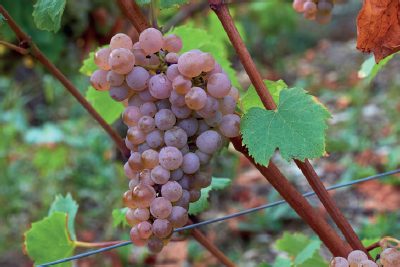
These images were taken in Le Cellier du Palais vineyard in Apremont during harvest: the top photo shows typical Jacquère bunches; the lower photo is a pink mutation.
Jacquère thrives on the rocky and steep limestone slopes of the Prealps. Its unrivalled stronghold is at the foot of Mont Granier in Apremont and Abymes, where more than 600ha are grown. Across the valley Chignin has another 90ha; there are 9ha at Cruet and about 170ha scattered along the Combe de Savoie. Chautagne and Jongieux have less than they used to, with about 50ha between them. These figures do not include plantings destined for Crémant.
Since the 1960s Jacquère has been valued as a cash crop, grown to make wine for a quick sale to satisfy a thirsty market, which is advised to drink it within a year of purchase. Yet for the past 15 years a handful of producers have proved that it can be much more than this, particularly from old vines. By picking later, limiting yields and using appropriate cellar techniques Jacquère can be made into a special, light white wine, which can age. It expresses its site too – a Jacquère from Apremont or Abymes does not taste like one from Jongieux or Chignin.
Jacquère is a hardy variety and produces high yields if left unchecked, hence its popularity when abundant crops were the main aim. It buds relatively early, and with its thick skins it is fairly resistant to downy and powdery mildew. However, it is susceptible to both black rot (see Growing the Grapes, here) and botrytis bunch rot.
It is usually the last white variety to be picked and the berries gradually turn from green to yellowy-green; some older selections develop a pink-toned green. Even if yields are held well in check this grape rarely manages to produce high sugar levels, though the Apremont producers Jean-Claude Masson and Domaine Dupraz achieve 12% in good years. A standard potential alcohol level today would be about 10% and in warm years 11% (the minimum required for the AOC before chaptalization is 8.5%; 9% for the crus and for Crémant).
Jacquère used to be regularly blended with Chardonnay or sometimes Altesse, even in Apremont and Abymes. Today up to 20% is allowed, but it is mainly the larger négociant houses that practise blending for their AOC Savoie still wines. Some producers blend it with more flavoursome varieties.to good effect in IGP Vin des Allobroges and IGP Isère.
There are five approved clones for Jacquère and an experimental vineyard has been planted for observation at Domaine Philippe et Sylvain Ravier in Myans, under the auspices of the CAAPG.
Jacquère wines
Chaptalization is common and most producers aim for a final alcohol level of 11–11.5% (the maximum allowed for AOC Savoie; it is 12% for crus). Jacquère is typically relatively pale, greeny coloured, with a nose of hawthorn, citrus, stony minerals or occasionally almonds. It should be dry, with a mountain freshness, lightweight but with sufficient fruit character – citrus, apple or occasionally riper, pineapple – to balance the acidity. That allusive word ‘minerality’ comes to mind particularly when tasting excellent Abymes and Apremont – and if you visit the vineyards and try to imagine the Mont Granier landslide, you can see exactly where that minerality or stony character comes from. Good Jacquère wines last easily through to the summer two years after the harvest, and from older vines and lower yields the ageing potential is several years longer.
High-yielding Jacquère is prone to high acidity and a low aromatic profile, so the big question is how to balance this. Many producers, especially in Apremont and Abymes, have juggled with both residual sugar levels and a slight spritz of retained carbon dioxide, which can be attractive if the sugar is not too high. The regional advisors have in recent years been trying to encourage lower sugar levels so as to highlight the grape’s mineral freshness, but also in a bid to crack down on the practice of stopping fermentation with excessive amounts of SO2. Latest vintages have still shown some worrying levels of sweetness and SO2. A few vignerons, most commonly in Chignin, have dabbled with malolactic fermentation. This can be a plus, but risks taking away from Jacquère its potential steely minerality, especially in recent, warmer vintages. In general Chignin and Jacquère from the Combe de Savoie, as well as from Jongieux, do taste fuller and riper than those from Apremont and Abymes.
For many years, some Savoie producers have made traditional method sparkling wines with Jacquère, alone or in a blend. Now that the Crémant de Savoie appellation is in place, with a requirement for a minimum of 40% Jacquère in the base wine blend, the variety is all of a sudden in even more demand. And it is being planted in areas where it did not exist before, in Haute-Savoie in both the Lac Léman vineyard areas and in Frangy. In Bugey, the little Jacquère remaining is used mainly in sparkling wine blends.
Good Jacquère wines define Savoie for many critics, but there’s work to be done for this grape to be recognized as one of the world’s greats. Outside the French Alps, there is said to be 3ha of Jacquère in Portugal.
Molette
Savoie, Bugey
Molette is an historic variety in Seyssel, but there is perilously little grown, particularly considering the latest (perhaps badly conceived – see Seyssel) requirements in the Seyssel sparkling AOC for a minimum of 75% Molette, blended with Altesse. The Seyssel Molette AOC for still wines has recently been created – traditionally it was simply the everyday white table wine consumed locally. The only Molette grown outside AOC Seyssel is possibly a tiny amount in Ayze and about 6ha in Bugey, where it is blended into Bugey Brut. Total plantings are likely to be 20–25ha. DNA testing indicates that Gouais and Gringet are Molette’s parents.
Molette crops well and is fairly tough, though sensitive to mildews. It ripens rather unevenly and relatively late at about the same time as Jacquère. It gives reasonable sugar levels but sometimes searingly high acidity, which is why it is most prized for making sparkling wines.
Old-vine Seyssel Molette (non-sparkling) gives good floral and grapefruit flavours with enough intensity to balance the acidity, but is too often covered up by residual sugar. There are two clones, one newly developed, and it is hoped that more of this rare variety might be planted.
Muscat à Petits Grains
Diois, Hautes-Alpes, Vin des Allobroges, Isère
This small-berried and likely most ancient of the Muscat grape varieties, considered the finest in quality, may have originated in Italy or Greece and has been known across the Mediterranean basin for many centuries. In the Diois, where it accounts for about 75–80% of plantings, they believe that Muscat fits with the description by Pliny the Elder in his Natural History, written in the 1st century AD, of a grape named Helvenaca, used by the local Voconces tribe to make a sparkling wine (see History, here). The next record in the Diois is in 1629, when the people of the area are said to have presented two ‘loads’ of Muscat to Louis XIII as he was passing through.
In the Hautes-Alpes, it is not certain that this white version of Muscat was present much before phylloxera, but the Allemand family consider it a traditional variety and it is grown by them and several other producers for both dry and sweet wines. Further north it is more anecdotal, although there is some evidence of it being a traditional variety in Savoie.
Muscat is very much the pride of Clairette de Die Méthode Ancestrale, which requires a minimum of 75% in the blend. And the natural red variant is used as part of the blend for rosé versions. Although considered a mid to late ripener, Muscat ripens before Clairette in the Diois; tests have shown that it is sturdy enough for machine picking, something that has only recently been allowed. Classically grapey and floral in flavour, the Clairette de Die wines are described more fully in the sparkling wine chapter. Still Muscat wines are mentioned in producer profiles in the relevant regions.
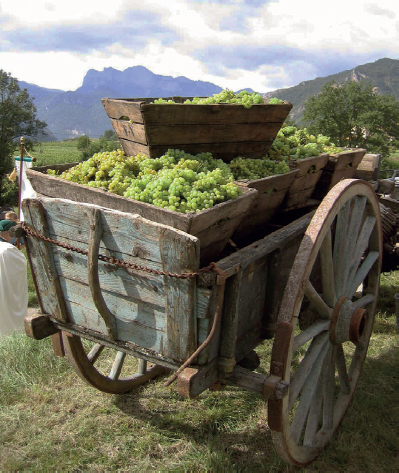
To make Clairette de Die, Muscat grapes are harvested not too ripe. The cart is not obligatory … the image is from a harvest festival.
RARE LOCAL WHITE VARIETIES
Mondeuse Blanche
Savoie, Coteaux de l’Ain
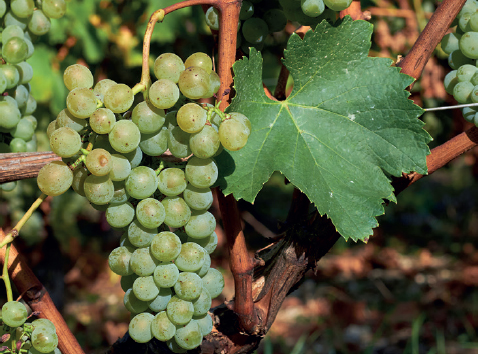
The late-ripening Mondeuse Blanche has been planted by a few growers, including Domaine Dupasquier.
An ancient Savoie variety, Mondeuse Blanche was identified by DNA testing in 1998 as the mother of Syrah, the happy father being Dureza. Previously it had been thought to be a variation of Mondeuse Noire, or the same as Molette, but Mondeuse Blanche is now known to be an entirely separate grape variety. According to José Vouillamoz, it is likely to be either a parent or offspring of Mondeuse Noire. It had died out completely in Savoie, but in the 1980s Roger Raffin and Gilbert Nicaise, local vineyard consultants and two of the founder members of the CAAPG, brought cuttings from the Vassal collection, had them grafted and asked Jean-Paul Finas, a now-retired vigneron in St-Pierre-de-Soucy, in the IGP Vin des Allobroges vineyards, to plant them. Those first vines are now farmed by Brice Omont of Domaine des Ardoisières, along with those planted at Cevins by Michel Grisard; the grapes are used in blends. Interest in Mondeuse Blanche grew and it has been planted in small quantities by several Savoie producers, including Domaine Dupasquier. Plantings are less than 10ha. In Bugey, it is grown in tiny quantities by Caveau Bugiste.
Mondeuse Blanche is a tough variety to grow, vigorous and productive, requiring much canopy work to control the shoots, which manage to grow downwards as well as upwards, and it’s more sensitive to disease than Mondeuse Noire. Once fully mature, late in the season, the acidity may already have dropped, so picking time is sensitive. If yields are not kept very low, the wine will be rather bland, but there is good potential for this variety, especially as part of a blend. Single-varietal Mondeuse Blanche at its best has a dry herbal character with decent weight and freshness too.
Roussette d’Ayze
Savoie
This very rare grape has nothing to do with Roussette, aka Altesse, but is an indigenous variety from the Ayze area. There are various hypotheses as to its origins. It has almost died out, despite being listed as an approved variety for AOC Savoie Ayze still or sparkling wines and for the other Haute-Savoie crus. According to Nicolas Montessuit of Ayze, who has a little, originally planted in the 1970s, it ripens early and has low acidity. It used to be grown to add roundness to the potentially austere Gringet grape, but for fine wines, it is not ageworthy.
Velteliner Rouge Précoce (Malvoisie)
Savoie, Isère
Malvoisie appears in old texts on Savoie, but the name also crops up in many parts of the world, for different, often unrelated grape varieties. In Savoie there are two versions of ‘Malvoisie’, with rarely a clue on the label as to which you will get: Velteliner Rouge Précoce, sometimes erroneously named Velteliner Rose, and Pinot Gris. What was grown traditionally in Savoie appears to have been the Velteliner Rouge Précoce or Frühroter Veltliner (Early Red Veltliner), an Austrian variety unrelated to the more famous Grüner Veltliner. This variety is listed in the 1803 inventory of grapes as Malvoisie Rouge or Malvoisie de Po and according to Wine Grapes has also been known as Malvoisie Rouge d’Italie.
In the official Savoie AOC rules, Velteliner Rouge Précoce is specified, and it is no longer permitted to write Malvoisie on labels. Adding to the complications is that around the turn of this century, when there was some excitement about replanting Malvoisie, there weren’t sufficient plants of Velteliner Rouge. Some of what was planted by producers including Domaine Grisard, Domaine A & M Quenard and Domaine Jacquin, was in fact Pinot Gris. In Isère Domaine du Loup des Vignes grows a little. In total, there is less than 10ha across the regions.
Technically Velteliner Rouge Précoce is a pink grape, whereas Pinot Gris is a grey grape. It is vigorous and subject to mildews and rots, and it ripens early, usually being the first grape to be harvested. Some vignerons make a dry white and others an off-dry or medium-sweet Malvoisie, which may be this grape or Pinot Gris or even a field blend – some vignerons don’t correctly identify which they have. The best examples show honey and spiced flavours, with alcohol around 12% and real ripeness of fruit balanced with acidity.
Verdesse
Isère, Savoie
One of the traditional grapes of Isère, Verdesse may also have existed in Piemonte in Italy. Current DNA research indicates that it may be an offspring of Savagnin. It almost died out with the sharp decline of vineyards in Isère and yet it has the potential to make excellent whites. Its name refers to the dark green colour (vert is ‘green’ in French) of its leaves and also the berries, which remain very green until just before they are ripe. I first came across it in the early 2000s from Michael Ferguson, a South African living and working in Grenoble, who replanted it in 1998 from a local grower’s cuttings and who sells tiny quantities under the name Mas du Bruchet. Since then it has been planted by several vignerons in both Isère and Savoie, though probably fewer than 5ha exist – all are excited by its quality potential and it is beginning to show in their wines.
It has the potential to produce high sugar levels, reaching 12.5% naturally and sometimes as high as 14.5%, so it’s no surprise that some producers make a late-harvest version with residual sugar, but its great advantage is that there’s always balancing acidity too. Flavours tend to be exotic, spicy and veering towards yellow fruit.
OTHER WHITE VARIETIES
Aligoté
Savoie, Bugey, Diois
This sturdy grape, originally from Burgundy, has long been thought to suit Alpine climates as it ripens relatively easily, but it is little grown today. There are a few hectares in Chautagne; in Bugey, Caveau Bugiste make a good example from old vines under the IGP Coteaux de l’Ain designation and some appears in blends elsewhere, especially for sparkling wine. In the Diois it is grown in a small way in AOC Châtillon-en-Diois.
Arvine/Petite Arvine
Vin des Allobroges
Even though there is no evidence that it was planted here historically, there is a growing fascination with Petite Arvine (also known as Arvine) in Savoie since it appeared on the French list of authorized grape varieties in 2010. It originates from and is increasingly widely grown in Valais in Switzerland, and in 1970 was introduced into the Aosta Valley in Italy – it certainly has an aptitude for growing in Alpine vineyards. Domaine Saint-Germain has some young vines and is using it in a white blend to excellent effect and Les Vignes de Paradis make a late-harvest version; a few other vignerons have also planted it.
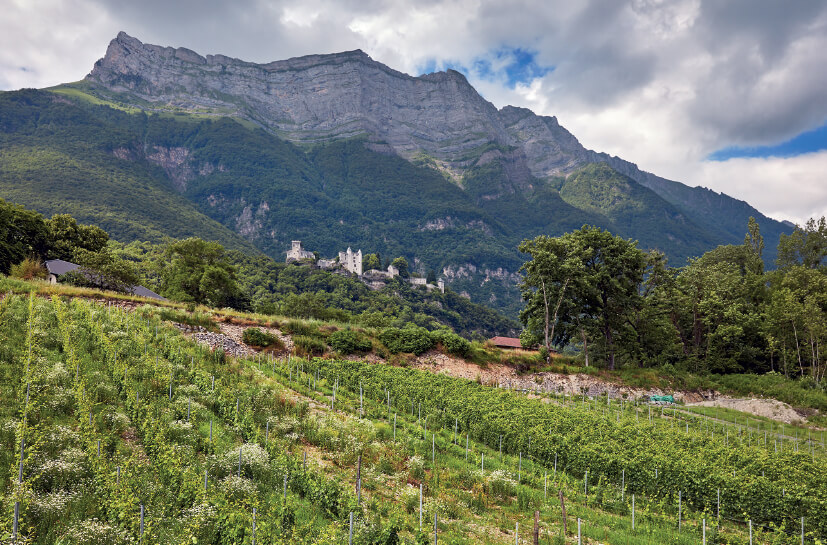
In this vineyard below Château de Miolans and the imposing Dent d’Arclusaz, Domaine Saint-Germain grows Petite Arvine; the estate was one of the first in Savoie to plant it.
Marsanne
All regions
The partner of Roussanne (aka Bergeron) in the vineyards of Hermitage in the Rhône Valley, and likely to be either the offspring or parent of Roussanne, it would not be surprising if Marsanne should also crop up in the French Alps. A tiny amount of Marsanne has been planted by Domaine du Petit Août in Hautes-Alpes, and there are pockets of plantings elsewhere.
Pinot Gris
Vin des Allobroges, Isère, Hautes-Alpes, Coteaux de l’Ain
In the 1803 Savoie grape inventory Pinot Gris appears as Malvoisie Blanche (see Velteliner Rouge Précoce). Technically Pinot Gris is not allowed in the Savoie AOC, but it is permitted as IGP Vin des Allobroges and several producers have a little, until recently labelled Malvoisie. Dominique Lucas of Les Vignes de Paradis makes a very good pure Pinot Gris from vines he planted in Crépy. There is some in Coteaux de l’Ain, Isère and Hautes-Alpes too, as this grape ripens relatively easily. Sadly, most have neither the freshness and delicacy of the best northern Italian versions, nor the dry richness and exotic character of the best Alsace versions.
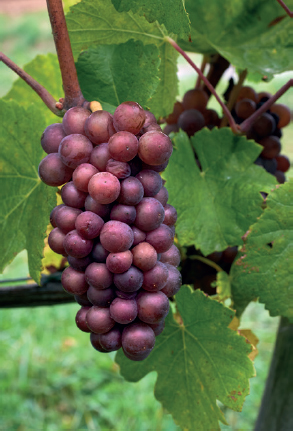
Technically a grey variety, this very ripe bunch of Pinot Gris from Dominique Lucas is almost the colour of Pinot Noir.
Viognier
Isère, Hautes-Alpes, Coteaux de l’Ain, Vin des Allobroges
Viognier is a traditional grape of Isère, often known under the synonym Galopine. Condrieu, the appellation that made Viognier famous, is only 60km southwest of the Isère Balmes Dauphinoises and there is a little grown here and in Coteaux du Grésivaudan. Viognier is closely related to both Mondeuse Noire and Blanche, so although at its northern limits, it should come as no surprise that it is also grown in a small way in Savoie and Bugey. In Hautes-Alpes, Domaine de Tresbaudon has 3ha. The biggest risk to this variety, grown so far north, is spring frost, but apart from this, with a warming climate, the French Alps seem an ideal place to make a fresh and balanced Viognier, not overblown by alcohol. With its floral and exotic fruit flavours, Viognier is ideal as part of a blend.
MAIN RED VARIETIES
Gamay
All regions
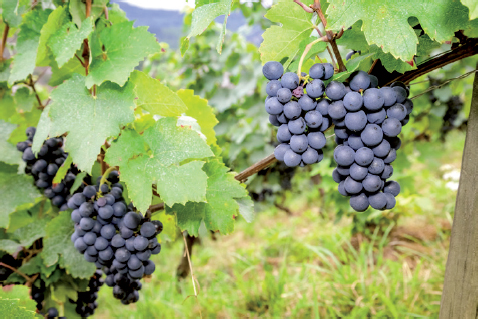
Gamay is right at home in Bugey Cerdon, here in Renardat-Fâche’s organic vineyards.
Gamay’s official name is Gamay Noir à Jus Blanc (black Gamay with clear juice) to differentiate it from Gamay de Bouze or its mutation Gamay de Chaudenay, which are teinturier grapes (with red juice). A tiny amount of these teinturier Gamays is still grown and they are permitted in IGP Vin des Allobroges.
Gamay is grown all over Savoie and Bugey, and across the French Alps for IGP wines. In Savoie it is the most planted red variety, covering about 14% of the AOC vineyards, although declining slowly as little has been replanted since 1990. In Bugey, where it is the main grape for Cerdon sparkling rosé as well as the principal red wine variety, it accounts for about 44% of total plantings. In the Diois, it is the main red grape in the small AOC Châtillon-en-Diois (sometimes blended with Pinot or Syrah) as well as recently being used in a sparkling rosé made in the ancestral method. Before phylloxera it was mentioned by Jules Guyot in his 1868 work Etudes sur les Vignobles de France (‘Studies of the Vineyards of France’) as being grown in Haute-Savoie, but there are few other mentions of it growing in the French Alps. Even in Cerdon, where it dominates today and which is located just 60km to the east of Beaujolais, home of Gamay, pre-phylloxera Gamay was just one of many varieties grown. But, after phylloxera and particularly in the post-Second World War period, Gamay, with its relative ease of growing, high and consistent yields and decent potential alcohol levels, undoubtedly helped save many vineyards from extinction.
It’s not all rosy for Gamay growers as it buds early, so is prone to frost (which was especially damaging in Cerdon in 2017), and its thin skins mean that it is easily damaged by hail and is very susceptible to mildews and botrytis bunch rot. Apart from for sparkling wines, Gamay tends to be picked after Chardonnay and Pinot Noir. In Cerdon it is picked before Poulsard.
In Savoie, it has long been the speciality of the warmer Chautagne area and was also until recently valued in Jongieux, but now Mondeuse is slowly taking over there for reds. In predominantly white wine areas such as Apremont, Abymes and in the Lac Léman district, Gamay tends to be grown to provide a little red and/or rosé wine, both still and sparkling, sometimes blended with other red grapes.
Perhaps more than for some grapes, how good the Gamay wines of the French Alps are depends partly on vine age and yield and partly on producer. There is a big advantage in Savoie now that the average vine age of Gamay is 30 or 40 years, but there is still a tendency to use it as a quick cash crop type of wine and thus over-crop it. Most producers make the wine in the traditional manner with a very short maceration, but increasingly semi-carbonic maceration is used. The best Gamays are full of joyous red fruit, with an extra vibrancy of acidity from the mountains; stony minerality is rarely a feature, as – except in Chautagne – Gamay is rarely grown on the best slopes. There are a few noble exceptions of Gamays that not only sing when young, but become profoundly delicious with a few years’ age – these are to be found mainly in Jongieux.
In addition to Cerdon’s ancestral method Gamay-dominated rosés, there are increasing examples of medium-dry to medium-sweet Gamay sparkling rosés from Savoie and Bugey, either made by the traditional method or by the ancestral method, the latter usually handled for producers by one of the larger Diois producers.
Mollard
Hautes-Alpes
The attraction of this grape is one of the reasons I decided to include the wines of Hautes-Alpes in this book. In his 1868 book Jules Guyot praised the characteristics of Mollard, which he found in the Hautes-Alpes and described as being between Gamay and Mondeuse in style, and I agree with him. As with so many rare grapes, its decline mirrored that of the vineyards of the Hautes-Alpes – in the 1950s there were around 300ha grown; by the start of this century there were only about 25ha. The few vineyards that remained in the Upper Durance Valley by the 1980s were often replanted with international varieties, but Mollard’s saviour came in the form of vigneron Marc Allemand, who worked to save and develop the plant material and two clones. He has over 4ha, which include some old vines grown at up to 700m altitude. It has also been replanted by Yann de Agostini, who has some very old vines too. Several other growers in the area still have a little and the local co-operative makes a single varietal version as well as blends. There is a tiny amount in Sonoma, California.
Mollard is likely to be an offspring of Gouais. It is sensitive to the two mildews and very productive, needing green harvest. It usually ripens well, with modest potential alcohol of 11–12%. Mollard has good colour and freshness, with rustic red fruit flavours and the structure to age. It’s often used in blends and for rosé too. For more details see the producer chapter on Hautes-Alpes.
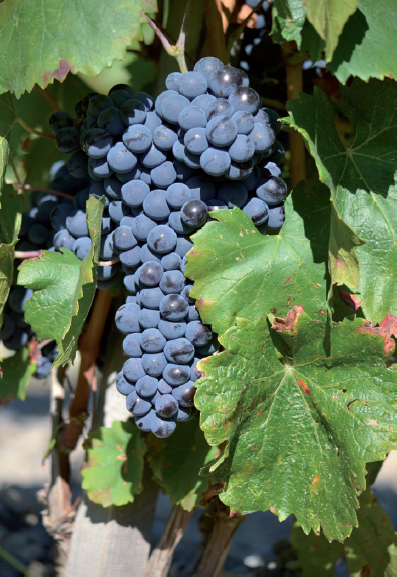
The rare Mollard variety was saved from extinction by Marc Allemand in Hautes-Alpes.
Mondeuse
Savoie, Bugey, Isère
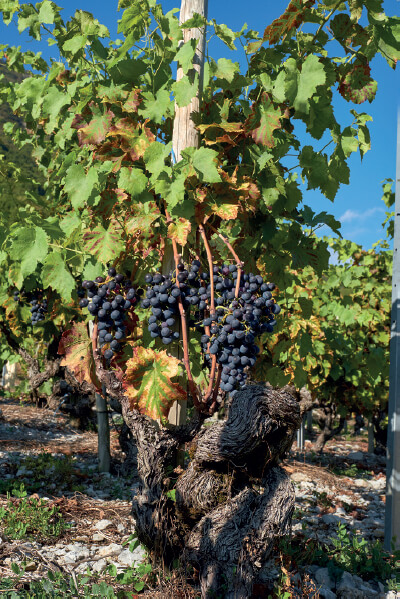
Mondeuse can be very productive even on very old vines, like this one in Arbin.
Known also as Mondeuse Noire, to differentiate it from Mondeuse Blanche, this has been Savoie’s most famous grape for centuries. Yet even after a deserved renaissance in recent years, it remains only the region’s second most-planted red grape, after Gamay, with about 250ha in the AOC vineyards and some more in the IGP vineyards. In Bugey there is less than 30ha, some of which is used for rosé and for sparkling base blends. A little is grown in Isère. Historically, in all three regions it was widely planted and highly regarded.
Mondeuse is known for being a vigorous vine, which ripens very late. After the arrival of chemical fertilizers, the combination of high yields with late ripening resulted in grapes with very little sugar or flavour, giving mean wines that required massive chaptalization. They were mean because the grape skins were not ripe and nor were the stems, and before the introduction of destemming machines, these could add green flavours too (see Making the Wines, here). All in all this was not a recipe for fine wine and yet Mondeuse had enjoyed an illustrious past – the French author Jules Guyot, in Etudes sur les Vignobles de France (‘Studies of the Vineyards of France’), published in 1868, waxes lyrical about Mondeuse as grown in the best vineyards of the Combe de Savoie and in Chautagne, writing that it has the same qualities as light Médoc wines and pointing out that it develops with age.
Having hit a low in the 1970s of about 150ha in Savoie, it was not until the 1990s that plantings began to increase again. By then, not only was there a growing appreciation of the value of indigenous varieties, but also some of the steeper slopes between Chignin and Fréterive in the Combe de Savoie, where traditionally Mondeuse has performed best, were being replanted, especially in Arbin and St-Jean-de-la-Porte, where wines must be made exclusively from Mondeuse in order to use the cru name. There are three approved clones, but at least one is very over-productive; the CAAPG’s experimental vineyard in Montmélian is trialling more.
Gradually in the past two decades the importance of better vineyard practice combined with better cellar handling has been taken on board and the wines may once again be considered as fine. The steepest, stoniest and best-exposed slopes are ideal. The best vignerons favour training Mondeuse either with Gobelet sur échalas on very steep slopes, or along wires using Cordon de Royat or Eventail (see Growing the Grapes, here), all systems that reduce the potential vigour. To further limit yields, bud rubbing and the use of green harvest (dropping bunches) are crucial. Mondeuse bunches can be very large, with distinctive ‘shoulders’, and some vignerons scrupulously cut off the shoulders, but there are several schools of thought.
Savoie’s most historic grape variety
The origins of Mondeuse have been subject to much misunderstanding and speculation in recent years. Two millennia ago, Vitis allobrogica was mentioned by various writers including the Roman agronomist Columella and the author of Natural History, Pliny the Elder. It was described by these writers as suiting limestone soils, coping with cold, ripening late and producing a wine of good quality, and for a long time it was believed to be Mondeuse. Modern ampelography asserts that the allobrogica vine described could have been Syrah, Pinot Noir or something else completely, but many believe it to have been some sort of heritage version of Mondeuse. The variety must have been grown in Savoie in the 18th century and possibly long before because it was mentioned in the 1803 inventory of grapes. It appears to have had many local synonyms, including Le Bon Savoyan in Savoie, Persagne in Ain, Gros Rouge in Switzerland and Maldoux in the Jura.
In the 19th century Mondeuse was taken to Australia (to Brown Brothers in Victoria) and to California. In the 20th century at the University of California at Davis the variety was misidentified, confusing it with Refosco dal Peduncolo Rosso of northeast Italy, a relationship disproved by DNA testing. Once Mondeuse Blanche was discovered to be one of the parents of Syrah, this paved the way for further testing to identify Mondeuse Noire. The latest research shows it to be an offspring or parent of Mondeuse Blanche and a relative – either a half-sibling or grandparent – of Syrah.
During most of the 19th century, Mondeuse was the most planted grape in Savoie and also in Bugey. After phylloxera it was hardly replanted at all in Bugey, but it was replanted in Savoie and in the 1950s remained important – records show plantings in France of more than 1,000ha in 1958, which would have included some in Ain and in Isère. The abandonment of vineyards on the steepest slopes and in certain valleys, especially in the Maurienne and Tarentaise Valleys, as well as in Isère, would have contributed to its decline. In addition, when the renaissance of the Savoie vineyards started in the 1960s and 1970s, Mondeuse was considered simply too difficult to achieve a profitable crop and unsuitable for modern tastes. Gamay became the post-Second World War red grape favourite.
As a late-ripening variety, vintage conditions make a big difference to Mondeuse wines and it is very much a beneficiary of climate change. A particularly challenging aspect of Mondeuse is that the grapes rarely reach more than 10.5–11% potential alcohol even on the best sites and at low yields. Vintage 2018 was a notable exception. The AOC requires a minimum potential natural alcohol of 9% or 9.5% and in some vintages even this low level is hard to achieve. In the winery, this low potential alcohol, combined with high potential tannin, needs careful handling to avoid ending up with an unbalanced wine. The use of oak has been truly mastered by very few producers.
Having been all but abandoned apart from in the Combe de Savoie and in the warmer Chautagne area, today Mondeuse is grown all over Savoie, albeit in very small quantities in Haute-Savoie. It is a variety that truly expresses its terroir in the structure and flavours of the wines. In Bugey, the best expression can be found on the steep, stony Montagnieu slope, but a little is grown across the southern Bugey vineyards, where some suitable slopes exist too. Some is grown in Isère.
There are small plantings in Switzerland; a few wineries in California make single-varietal Mondeuse, notably Lagier Meredith; Brown Bros in Australia grows a small amount; and Cottanera in Etna, Sicily, makes a wine from vines planted in 1997 when it was sent instead of Syrah from a Savoie vine nursery. As a naturally low-sugar variety with a long growing season this grape could have great potential in the face of climate change.
Mondeuse wines
Much Mondeuse is made in a fruity style to be bottled quickly and consumed within two years of the vintage. However, at its best, sometimes with oak ageing, it gives spicy, peppery, dark red fruit and earthy flavours and has the structure to allow bottle ageing for 5–10 years and sometimes more. The established top vignerons believe that chaptalization to achieve 12% alcohol is essential for the wine to be balanced and ageworthy, but several of the new generation of Savoie vignerons are daring to bottle it at a much lower alcohol. Give a Mondeuse blind to a wine aficionado and they will rarely guess the real alcohol, nearly always thinking it to be 1–2% more than it is, such is the intensity of flavour and texture of the best examples.
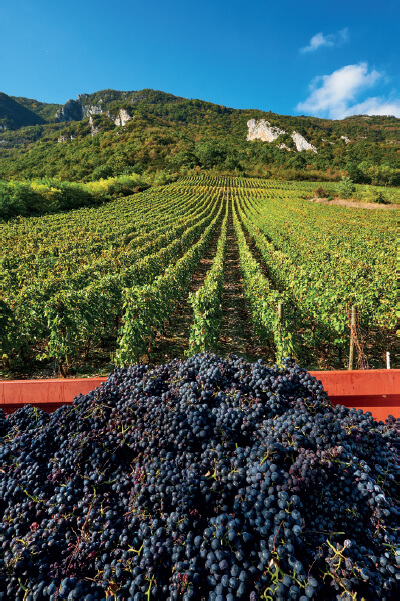
The tough-skinned Mondeuse is usually the last variety to ripen in Savoie, and the best producers like Domaine Genoux wait to pick as late as possible.
The appearance of Mondeuse wines is usually mid to dark ruby red, with medium to full intensity, and the colour fades only very slowly with age. Red fruits and spicy, earthy characters dominate, but occasionally there will be an almost Syrah-like floral element or even white pepper. Mondeuse from Apremont, Jongieux, Chautagne, Haute-Savoie and even Chignin tends to be lighter in every aspect than those from the Combe de Savoie – this is partly because in these regions the steepest vineyards are often reserved for other grape varieties. They can, however, produce wines with joyous red fruit with a surprising kick of structure. The acidity levels, while rarely very high, can add an acidulated character to the red fruit. Arbin produces the deepest, richest, most tannic and long-lived Mondeuse, but the potential of St-Jean-de-la-Porte and other villages in the Combe de Savoie is not far behind and it is from these that the floral notes tend to emerge with a slightly gentler structure.
Oak barrel ageing is used by several producers for a special cuvée; it often adds a spicy edge and a hardness, nothing more. However, there are a few producers, who will be noted in their profiles, who make wines at low yields, with enough power to marry well with oak. Wine lovers may be tricked into thinking there is oak ageing simply by the inherent spicy and powerful character of Mondeuse.
In Bugey, Montagnieu red must be 100% Mondeuse, but very little is made; the steep stony slopes are ideal and based on examples from Franck Peillot or Yves Duport, for example, it would be good to see more grown there. Many vignerons use it in their blend for Montagnieu Brut. Most Bugey Mondeuse has simple red fruit flavours and does well only in the best vintages.
In particular in the IGP areas, Mondeuse is occasionally blended with other varieties, as it often was centuries ago. In all areas, Mondeuse is sometimes used to make delicious dry varietal rosés, or included as part of a rosé blend.
Persan
Savoie, Isère
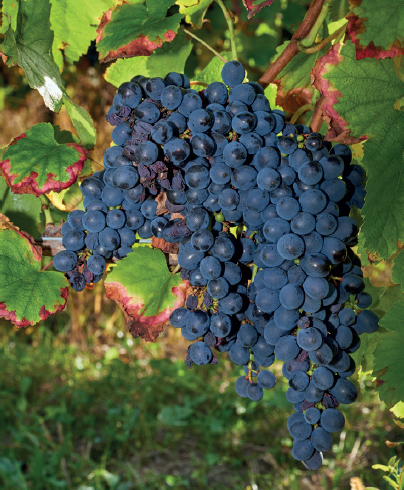
Domaine Giachino is one of the few Savoie vignerons to have successfully reintroduced Persan.
Persan is thought to have originated near St-Jean-de-Maurienne in an area called Princens (see here), the derivation of the Persan name and a local synonym. Widely planted and much revered until phylloxera, it was replanted afterwards and there were still 200ha in the late 1950s. But, as the vineyards in the Maurienne Valley died out due to industrialization, so – almost – did Persan. From a low of about 3ha, the variety is now being revived. In the French Alps it has been confused over the years with Mondeuse Noire, Etraire de la Dui and even Syrah. DNA profiling has proved it to be the same as a grape grown in the mountains of Piemonte in Italy, called Bécuet, and also that it is probably the parent of Etraire de la Dui. One of its parents is thought to be Savagnin and the other has not yet been identified.
Persan is distinctive in the vineyard as its berries are oval-shaped and look almost like black olives. It buds early, which can be a frost risk, and it is very susceptible to both mildews. It does, however, ripen well, giving good potential alcohol levels – considerably higher than Mondeuse – along with high acidity, which allows it to age.
In modern times, until the turn of this century, Persan was confined to scattered vineyards in the department of Isère, south of Chambéry towards Grenoble, where, confusingly, it is often named Serine, a synonym also for Syrah. Revived interest in old varieties led it to be planted by several growers, notably in 2000 by Michel Grisard in the Domaine des Ardoisières vineyard in Cevins (IGP Vin des Allobroges). Michel recalls that his father had always retained some Persan vines in the vineyard he used for his vine nursery, and Michel believes that Persan should be planted for blending as it was in former times. Another vine nurseryman, the late Gilbert Bouvet, was possibly the first in the 1990s to have made a Savoie wine with it, in an unusual oak-aged blend with Cabernet Sauvignon, named Amariva, still made by the estate today.
More growers, especially in the Combe de Savoie, have now planted Persan; it has also been replanted in the Maurienne Valley, where there are experimental vineyards, including at Princens. Persan’s number one cheerleader is Nicolas Gonin in Isère, who exports his Persan widely. However, it is estimated that there is still less than 20ha planted, with most growers having only 0.5ha or less. For now, growers are cautious, due to its erratic ripening and disease susceptibility, and also because they are not sure yet of their traditional customers’ reaction to it. The Savoie AOC’s restriction of not growing more than 10% accessory grapes (as Persan is categorized) may also be holding it back.
Persan wines
Occasionally blended with Mondeuse or other rarer varieties, Persan is mostly made as a single variety (with sometimes up to the permitted 20% of Mondeuse or other red grapes). Winemaking is still experimental, so some use oak ageing and others don’t. It gives wines of a deep colour with dark plummy or mixed berry fruit flavours and the acid and tannin structure for ageing. Persan wines are prone to reduction, so they take a while to open up in the glass. There is ageing potential of 5–10 years with good Persan wines, but it remains to be seen whether its quality and ageing potential can equal Mondeuse.
Pinot Noir
All regions
In terms of percentage plantings in the French Alps, Pinot Noir is most important in Bugey, where it represents around 6.5% of total plantings. It is the only permitted red for Bugey Manicle, where its history goes back to the period after phylloxera at the end of the 19th century. There is no history of Pinot Noir growing in Savoie until after the Second World War. Little by little the amount grown there has increased, so that now it represents 5% of plantings, some used for traditional method sparkling wine, some for reds and some, very occasionally, as part of rosé blends. There is a little Pinot in Isère, in Châtillon-en-Diois in the Diois and in Hautes-Alpes.
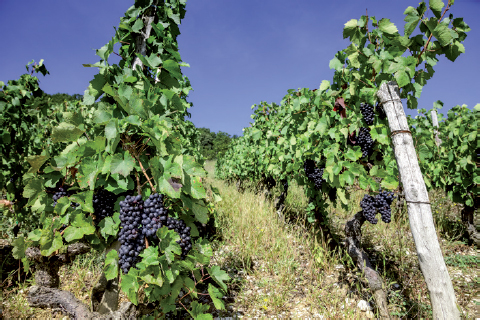
Pinot Noir ripens well on the steep slopes of southern Bugey.
In the prevalent limestone soils, Pinot suits anywhere with sufficient sunshine, although like Gamay it is prone to rot or mildew in poor summers. It matures relatively early with good sugar levels, so its attraction in these regions is obvious. As everywhere with Pinot Noir, more than most varieties, the success of the wine is very much in the hands of the vignerons. You would expect these Pinots to be lighter than Burgundies and they are, but occasionally, especially in good summers, the true Pinot characteristics of red fruit and even gameyness emerge to make some delightful wines. A few producers age in oak, but most make it in a simple fruity style.
Poulsard
Bugey
The notoriously difficult but increasingly admired red grape of the Jura, Poulsard is grown in the Cerdon part of Bugey, which is effectively an extension south of Jura’s Sud Revermont district. Pre-phylloxera more was planted, but today there are less than 15ha of Poulsard, used in a blend with Gamay for Cerdon Méthode Ancestrale, the pink semi-sweet sparkling wine. In the rainy climate here, it is just as challenging as in the Jura, prone to fungal and other diseases and to over-cropping, and requiring very careful handling in the cellar. I don’t know of any red or rosé still wines made from it.
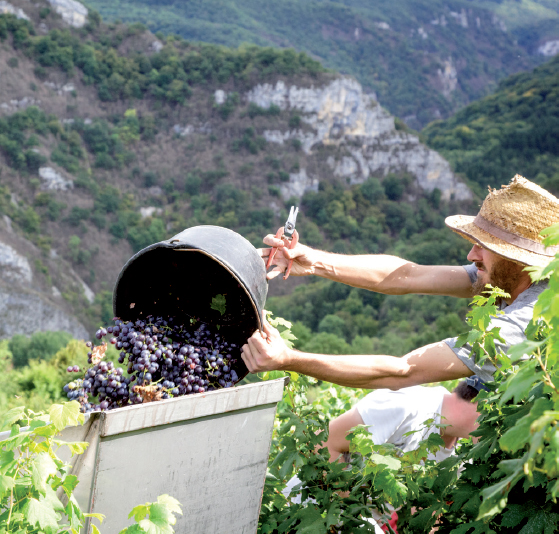
The only place that Poulsard is grown outside the Jura is here in Bugey Cerdon.
RARE LOCAL RED VARIETIES
Douce Noire/Corbeau
Savoie, Isère
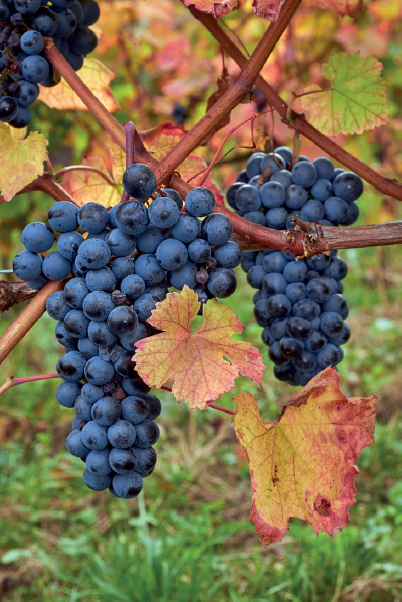
With its highly coloured leaves, at harvest time Douce Noire is one of the prettiest grape varieties – it was once widely grown in Savoie and Isère.
Corbeau is known in the French Alps as Douce Noire (which means ‘sweet black’). It was widely grown in Savoie in the 19th century and even post-phylloxera, up to the 1950s, Douce Noire was among the most planted red varieties, but was never considered to be as fine as Mondeuse. Elsewhere in France it was often named Corbeau (after the word for crow, because its wine was so dark-coloured) and in Jura it appeared as Charbonneau. DNA testing has proved that it is identical to Charbono in California and to Bonarda in Argentina (not the same as Italian Bonarda). In Argentina it is the second most-cultivated variety, with more than 15,000ha – compared with less than 3ha in France. In Savoie it was also known as Plant de Montmélian and despite other hypotheses having come and gone (notably that it might have been the same as Piemonte’s Dolcetto), it is now believed to have originated in Savoie.
Douce Noire gives low potential alcohol levels, but traditionally it was used for blending to add colour to Mondeuse as well as softness, and also to add softness to Persan. Curiously, despite the grape being widely planted not only in Savoie, Ain and Isère, but also elsewhere in France with a total 962ha, in 1958 it was dropped from France’s national grape register. This meant that it was not included in Savoie’s VDQS regulations and is still not permitted for the Savoie AOC. Fifty years later in 2008 it was finally restored to the register, under the name of Corbeau, thanks to the work of Roger Raffin (later president of the CAAPG) and vigneron Jean-Paul Finas (now retired). In 2011, the Douce Noire name was officially accepted.
Today, the Bachelliers at Les Sartos du Bec in the Maurienne Valley have experimental plantings of different mass selections. They have used it in red blends and more recently as a delicious varietal ‘nouveau’ style, made with carbonic maceration and full of red fruit: they see Douce Noire’s deep colour, high acidity, red fruit character, but low alcohol, as an advantage. It is grown by a few other vignerons, including Domaine Giachino, who use it in a blend with Mondeuse and Persan, called Ma Douce.
Espanenc/Plant Droit
Hautes-Alpes
This variety was once widely grown in the Hautes-Alpes, but almost died out. In France there are nearly 20ha as it survives in small quantities in the southern Rhône Valley (as Cinsault Droit); it is also grown in Spain as Garnacha Francesa. It is believed to be related to the white Clairette grape.
In Hautes-Alpes, Yann de Agostini of Domaine du Petit Août found 0.5ha of old vines, farmed by a member of Cave des Hautes Vignes, the local co-operative. He took mass selections for new plantings from 2010 to 2017, giving him 0.3ha in total. He made a tiny quantity from the 2015 vintage, which showed a classic Alpine structure and acidulated red fruit; his 2016 has more structure; sadly he made none in 2017 due to spring frost. Cave des Hautes Vignes uses Espanenc only as part of a blend.
Etraire de la Dui
Isère, Savoie
This now rare grape is believed to originate in Isère’s Coteaux du Grésivaudan valley and was first mentioned in the early 19th century. Its name comes from a farmhouse named L’Aduï where an enormous vine was discovered growing by a spring. Etraire was the name of Persan in Isère, and it looked similar, with oval-shaped berries, so the same name was adopted with the La Dui suffix. It was subsequently propagated and spread to Ain and Savoie. It is relatively sturdy and not too prone to fungal diseases, which aided its popularity, and initially it was rumoured to be resistant to phylloxera. DNA testing has confirmed that it is indeed a likely offspring of Persan. With the decline in the Isère vineyards from the late 1950s, the variety nearly died out, but Thomas Finot and Domaine des Rutissons have rescued some old vineyards and replanted it too. Today there are around 10ha grown. It appears to be best suited to clay-limestone vineyards; it buds early, so is risky if there is a late frost, and it is potentially over-vigorous. For Savoie vineyards located in Isère, it is permitted for the AOC, but most appears as IGP Vin des Allobroges or IGP Isère.
Etraire de la Dui is sometimes blended, but there are also single-varietal wines. It has a medium colour and on the nose has a floral character, but the palate can give a shock of acidity, tannin and even bitterness, so it needs good ripeness to provide balance. Potential alcohol is rarely more than about 12% and this is certainly a grape with potential to age for a few years.
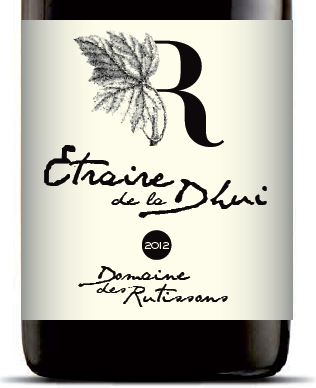
The official name is Etraire de la Dui, but there are many alternative spellings.
OTHER RED VARIETIES
Cabernet Sauvignon, Cabernet Franc and Merlot
Hautes-Alpes, Savoie, Coteaux de l’Ain
The surprise is finding the two Cabernets authorized in the AOC Savoie rules, but this is a legacy of the prevalent vine nurseries in Savoie, which sell vines to other regions. In Savoie for some decades there has been a tiny amount of Cabernet Sauvignon grown and commercialized, some in Chautagne, made by the co-operative, and some in the Combe de Savoie, made by Domaine Bouvet. All three varieties are found at several producers in the Hautes-Alpes either as single-varietal wines or as part of blends – Merlot is particularly useful in this respect. Cabernet Sauvignon may have difficulty ripening in these areas, but Cabernet Franc has good potential here.
Gamaret
Coteaux de l’Ain, Vin des Allobroges, Isère
This is a Swiss crossing of Gamay and Reichensteiner, created in 1970 and widely grown in the Geneva canton. It’s no surprise that it has crossed the border to Ain and there is some interest in using it in Savoie, where it is permitted for IGP Vin des Allobroges. It is relatively disease free and ripens early. It is known for its deep colour and intense tannins, therefore makes a good blending partner.
Syrah
Isère, Châtillon-en-Diois, Hautes-Alpes, Coteaux de l’Ain
Syrah has a long history in Isère and a little is grown in the Balmes Dauphinoises vineyards. Further south it is permitted as an accessory variety in AOC Châtillon-en-Diois and is grown by one or two producers in Hautes-Alpes for blends or single-varietal rosés and reds.
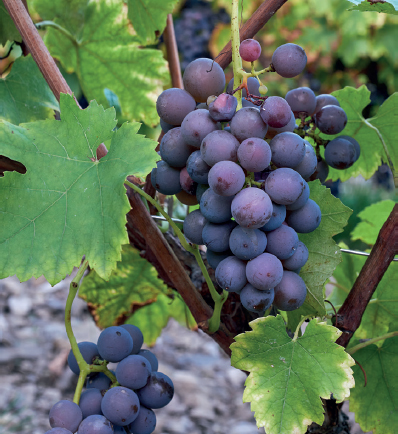
Mondeuse Grise was a surprise find, and now it is being rehabilitated by Philippe Grisard; other vignerons plan to plant it.
Very rare local varieties
The following grape varieties are traditional to one or more of the French Alpine wine regions and are in the process of being rehabilitated, although there is often less than 1ha currently planted. Inevitably, the list is not exhaustive.
White grapes
Bia Blanc: Savoie, Isère
Possibly related to Viognier and Mondeuse Blanche. There are some old vines interspersed with Jacquère at Domaine Dupraz. Cuttings from two different sources are being replanted and tested. There is a lot of interest from vignerons, including Nicolas Gonin, who plans to plant some in Isère Balmes Dauphinoises as soon as it is available.
Blanc de Maurienne: Savoie
DNA testing has proved that this grape from the Maurienne Valley is the same as the Rèze, a rare but much-admired grape grown in Switzerland’s Valais canton. It has been replanted in Maurienne and the first trial wines made from it.
Petite Sainte Marie: Savoie, Isère
Originally known as Ste-Marie de Chignin, this old grape variety has recently been approved, but the authorities have insisted on the name Petite Sainte-Marie as place names are not allowed; this despite the fact that Petite Sainte-Marie was also a local synonym for Chardonnay, to which it is not related. Gilles Berlioz has planted 400 vines and made some micro-cuvées and describes it as very flavourful and fruity. Some exists in Bugey and Isère too.
Other varieties: A few vines of Cacaboué, a traditional Savoie variety from Charpignat by Lac du Bourget, have been planted in the vineyard of the luxury hotel/restaurant Château de Bourdeau, to be used in a sparkling field blend. Once it has been reclassified and given a new name, Thomas Finot plans to grow Sainte-Marie de Biviers in Isère. Dongine is under consideration in Bugey.
Red grapes
Mècle de Bourgoin: Isère
Originating from close to Bourgoin Jallieu in the Balmes Dauphinoises and possibly a descendent of Savagnin, this variety was confused with Poulsard, because in nearby Ain Mècle was a synonym of the Poulsard. Nicolas Gonin found an old vineyard from which to take cuttings; he has planted 0.3ha and made 50 litres in 2018. Deep coloured, it seems to be between Mondeuse and Persan in style.
Mondeuse Grise: Savoie
Some years ago Claude Paul alerted the CAAPG to the existence of a grey variation of Mondeuse Noire in Bugey. Testing proved it to be a natural variation (like Pinot Gris is to Pinot Noir). It has now been officially registered and Philippe Grisard has planted some and made an interesting pinkish-tinged white wine.
Onchette: Isère
A progeny of Gouais, this variety has been rescued by the CAAPG together with the association that is reviving the vineyards in the high-altitude Trièves district southeast of Grenoble. Samuel Delus of Domaine de l’Obiou made the first experimental wines from 275 vines planted in 2010; more has been planted since. The variety has now been approved and Samuel uses it in a blend for a classic light red mountain wine.
Other varieties: Thomas Finot has planted Serénèze de Voreppe and Sébastien Bénard has planted Servanin, both in Isère. Nicolas Gonin plans to plant Salagnin (also known as Robin Noir) and Servanin in his Isère vineyards. Maxime Dancoine has planted Joubertin in Aiton. Jacquère Noire (found among vines planted at Château de Bourdeau), Hibou Noir and Peloursin (which exists in the Jura under the name of Gros Béclan) are among others under current research.